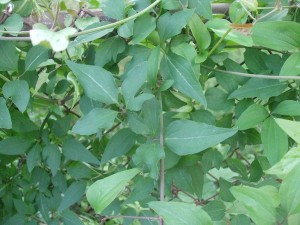
Sweet autumn clematis (C. terniflora). (C) Morguefile.com
One of the best flowering plants of late summer and fall has shown up on the radar of the state’s invasive plants group.
Sweet autumn clematis (C. terniflora, sometimes listed as C. paniculata) lives up to its name with its sweet, fragrant white blooms in August and September.
If you’ve grown this hardy, perennial vine from Asia, you know how invasive it can be in the backyard. It self sows like mad. Seedlings seem to sprout about anywhere they land, even great distances from the original plant. It’s one of those that you only need to plant once because it will have dozens of offspring.
Sweet autumn clematis blooms the same time as the native virgin’s bower (C. virginiana) and the two are hard to distinguish. Each blankets neighboring plants and fences with its star-like flowers. They both grow well in sun and shade and are not fussy about soil or water requirements.
“This is a good time to double check to make sure it’s really the native virgin’s bower, and not the invasive sweet autumn clematis,” said Ellen Jacquart, a director of stewardship at the Nature Conservancy and a member of the state’s group that evaluates invasive plants.

The native, fall-blooming clematis leaf (C. virginiana) has uneven, or toothed edges. Photo courtesy USDA NRCS Wetland Science Institute
“The flowers look pretty much the same, so you have to look at the leaves to tell which is which,” she said. The native species has teeth or jagged edges on the leaves, and the Asian variety has smooth-edged leaves.
Already on the list of invasive species in many other states, Clematis terniflora is not detected frequently in Indiana except in the Indianapolis area, where it has shown up in several natural sites, Jacquart said.
The plant has escaped our yards and shown up in natural areas, such as parks and woodlands, she said. “It may be that there are more sites, but people are assuming by the flowers that it is the native clematis.”
Because it heavily self sows, the Asian type can quickly overwhelm and displace native species.

Invasive clematis leaf (C. terniflora) has smooth edges. (C) Jo Ellen Meyers Sharp
What can you do? Remove the invasive species and replace it with the native one. The latter will be a bit harder to find, but there are online retailers and some garden centers that will have it. Search for it by the species name.